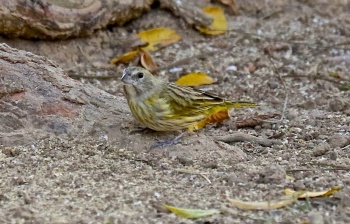- Sicalis flaveola
Identification
Length 13·5–15 cm (5¼-6 in)
Male
- Bright yellow overall plumage
- Orange crown
- Black edges to back and flight feathers
- Dark eyes
- Greyish-pink legs
- Greyish-black upper mandible
- Ivory lower mandible
Female: Heavily streaked with edges of primaries and tail yellow.
Immature: Same as female.

Photo © by Stanley Jones
South Wild, Pantanal, south of Poconê, Mato Grosso, Brazil, 5 August 2015
Variations
In northern subspecies such as nominate, the female resembles the male, but lacks orange coloration on the head. Juveniles lightly streaked dorsally with yellowish patch on chest.
Distribution
South America: found from eastern Colombia, Venezuela, Guyana, Ecuador, Peru, Bolivia, north-eastern and south-eastern Brazil, Paraguay, Uruguay, Chile and northern Argentina
This species has been introduced via the cage-bird trade to several other tropical areas (Panama, Puerto Rico, Hawaii, etc.).
Taxonomy
Subspecies
Four subspecies are recognized1:
- S. f. flaveola:
- S. f. valida:
- S. f. brasiliensis:
- Tropical north-eastern Brazil (Maranhão, Minas Gerais and São Paulo)
- S. f. pelzelni:
Some sources also recognize koenigi2 merged with S. f. pelzelni here.
Habitat
They use a wide variety of habitats, open lowlands with trees and shrubs. Towns, parks, farms. To 2100m.
Behaviour
Diet
Their main diet consists of seeds, with the addition of some arthropods. They feed on the ground, including town gardens.
Breeding
They are cavity nesters. The clutch consists of 3-5 eggs which are incubated by the female alone for 14 days. The young are fed by both parents and fledge at around 2 weeks old. See also the note under this image.
Vocalisation
Song is a musical series of of chips and short whistles with notes modestly spaced. Call-note is loud and metallic.
Movements
Sedentary.
References
- Clements, J. F., T. S. Schulenberg, M. J. Iliff, S. M. Billerman, T. A. Fredericks, B. L. Sullivan, and C. L. Wood. 2019. The eBird/Clements Checklist of Birds of the World: v2019. Downloaded from http://www.birds.cornell.edu/clementschecklist/download/
- Avibase
- Rising, J. & Jaramillo, A. (2020). Saffron Finch (Sicalis flaveola). In: del Hoyo, J., Elliott, A., Sargatal, J., Christie, D.A. & de Juana, E. (eds.). Handbook of the Birds of the World Alive. Lynx Edicions, Barcelona. (retrieved from https://www.hbw.com/node/62084 on 6 February 2020).
- Pratt, H.D., Bruner, P., and Berrett, D.G. (1987) A Field Guide to the Birds of Hawaii and the Tropical Pacific. Princeton University Press.
- Pyle, R.L., and P. Pyle. 2017. The Birds of the Hawaiian Islands: Occurrence, History, Distribution, and Status. B.P. Bishop Museum, Honolulu, HI, U.S.A. Version 2 (1 January 2017) http://hbs.bishopmuseum.org/birds/rlp-monograph/
- Saffron Finch (Sicalis flaveola), In Neotropical Birds Online (T. S. Schulenberg, Editor). Cornell Lab of Ornithology, Ithaca, NY, USA. retrieved from Neotropical Birds Online: https://neotropical.birds.cornell.edu/Species-Account/nb/species/saffin
Recommended Citation
- BirdForum Opus contributors. (2025) Saffron Finch. In: BirdForum, the forum for wild birds and birding. Retrieved 27 April 2025 from https://www.birdforum.net/opus/Saffron_Finch
External Links
GSearch checked for 2020 platform.1





